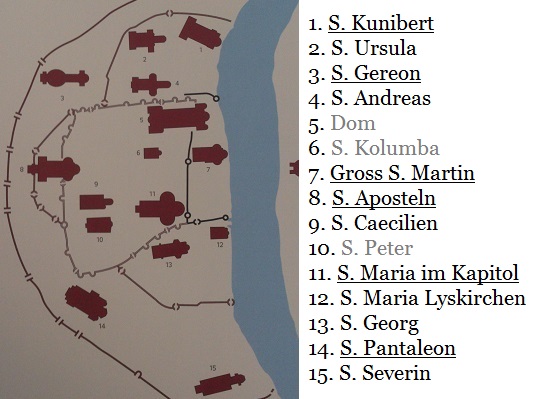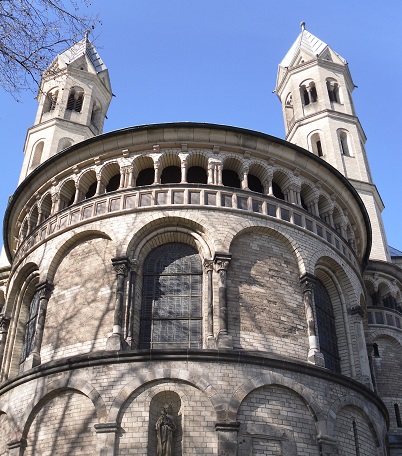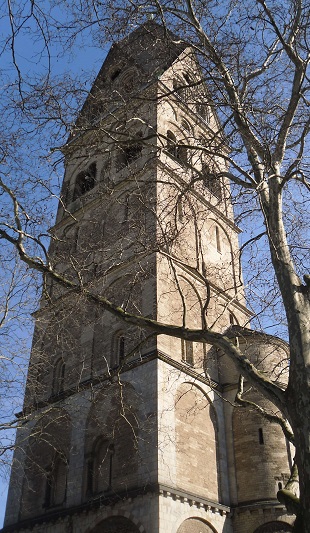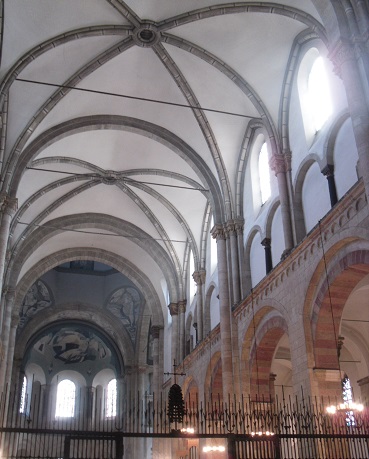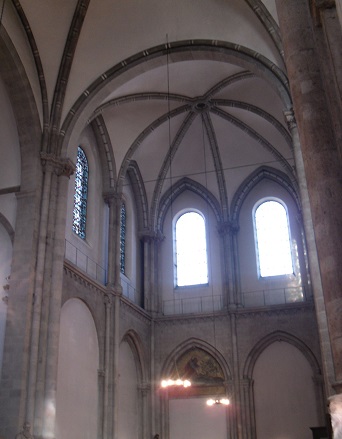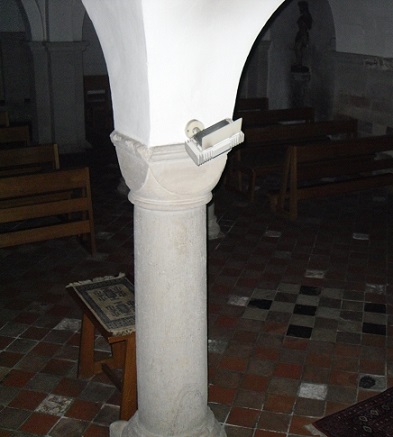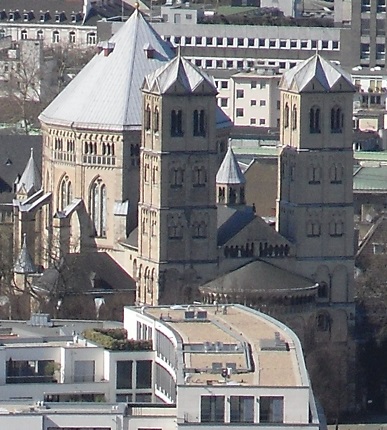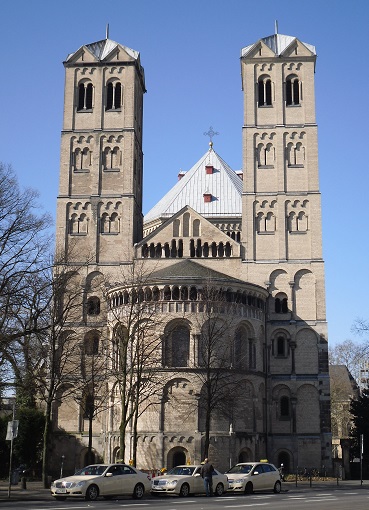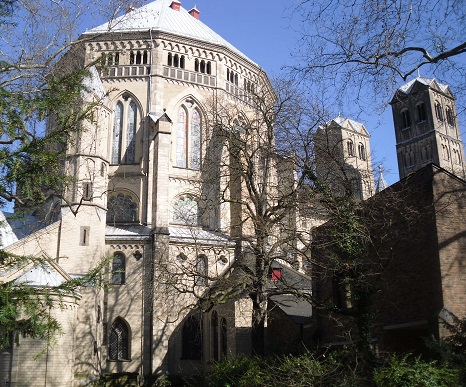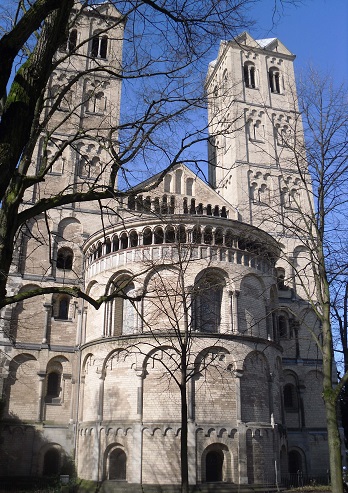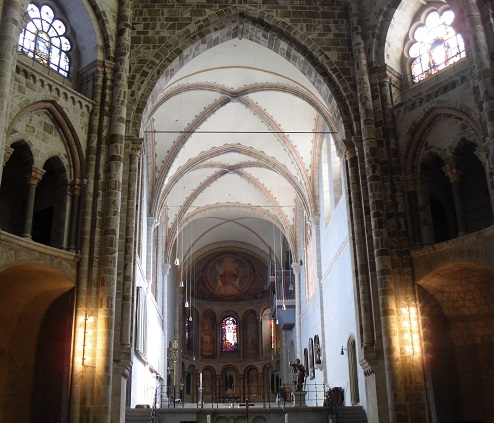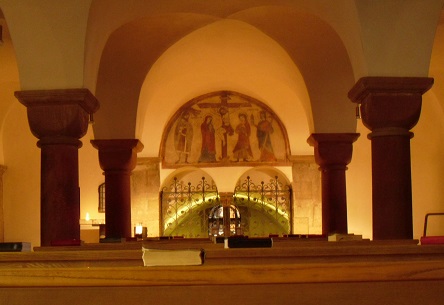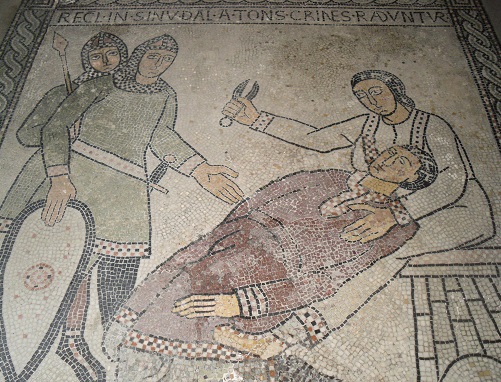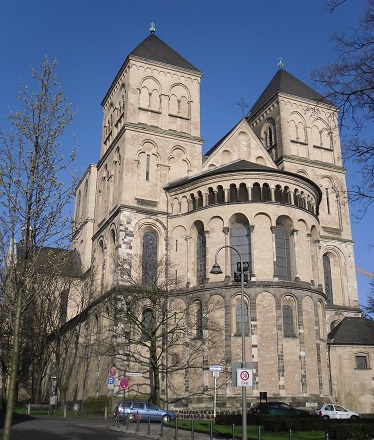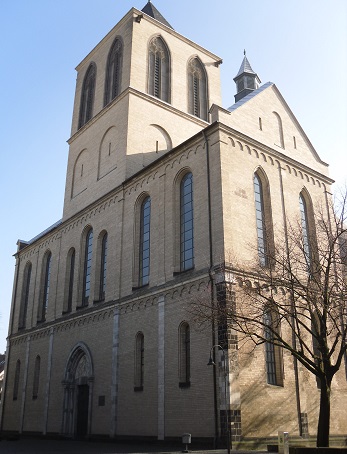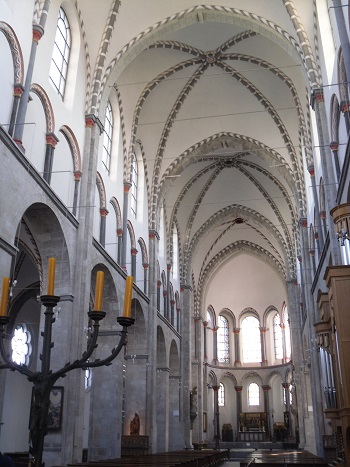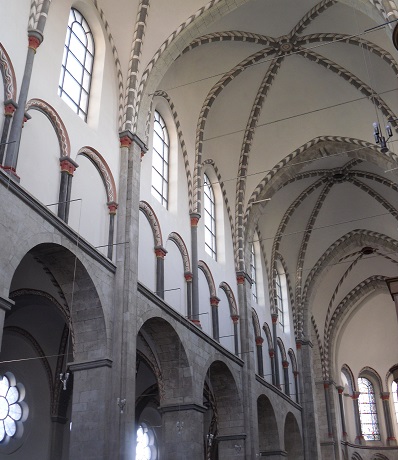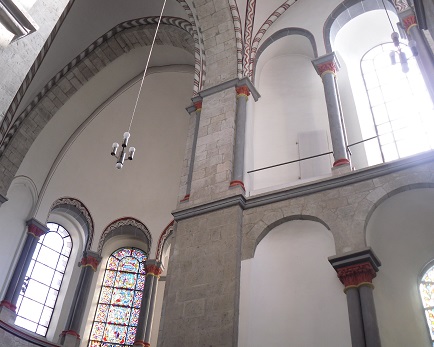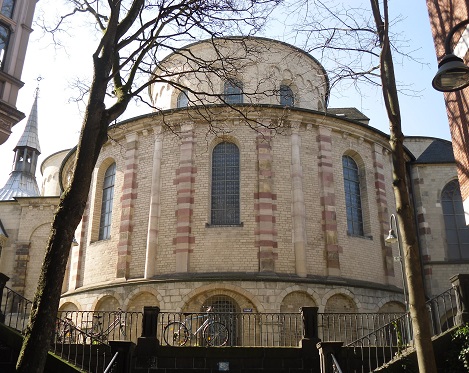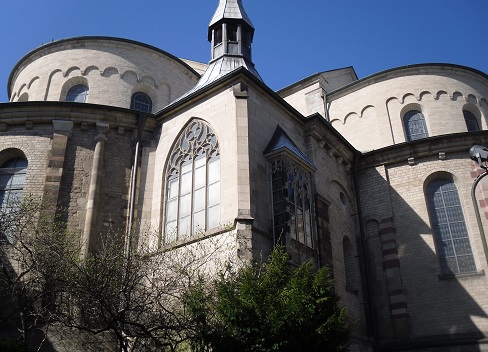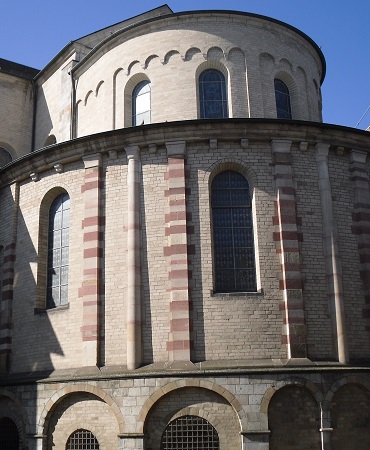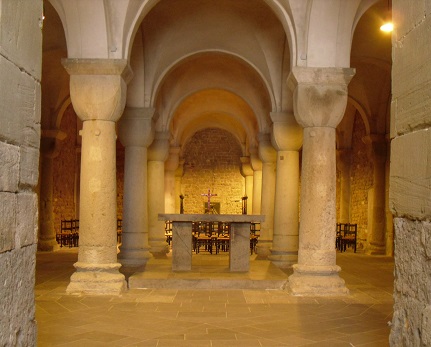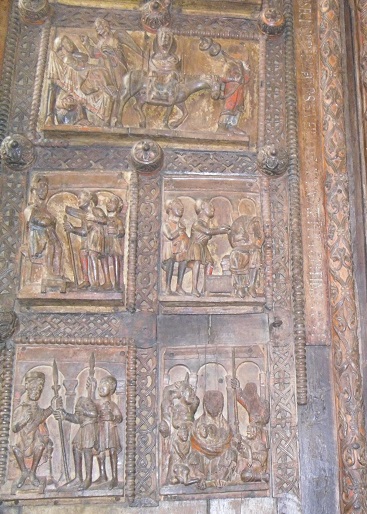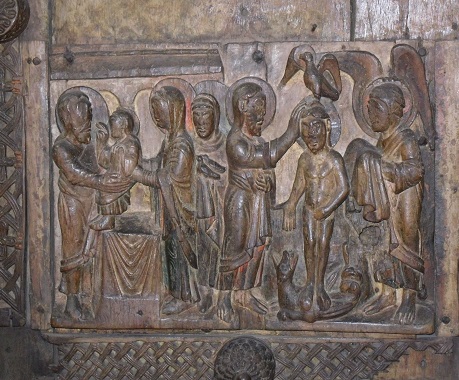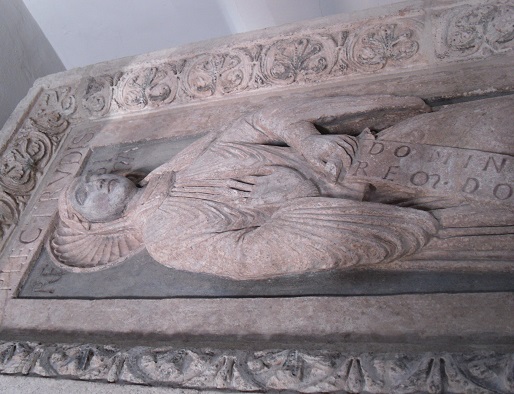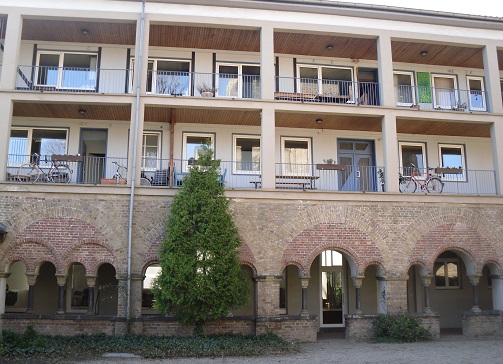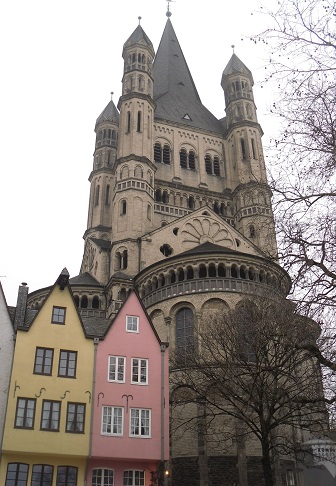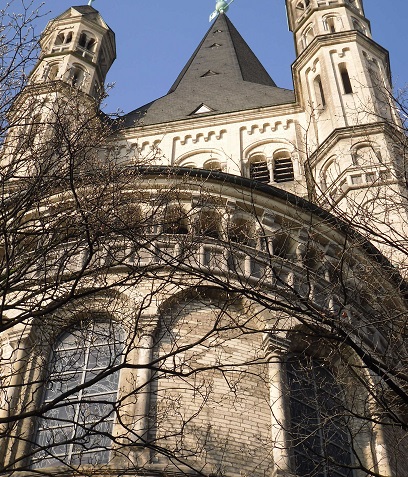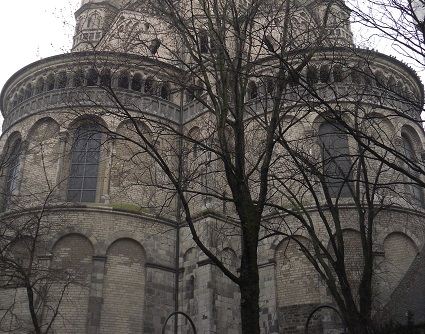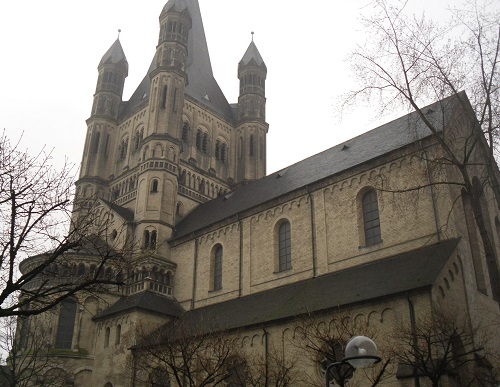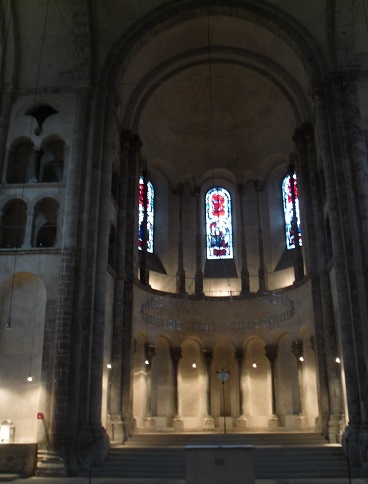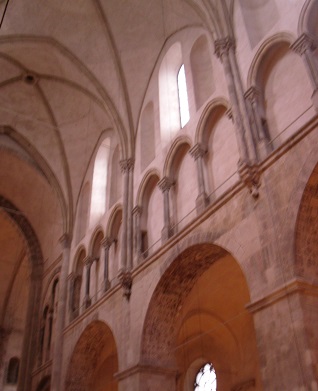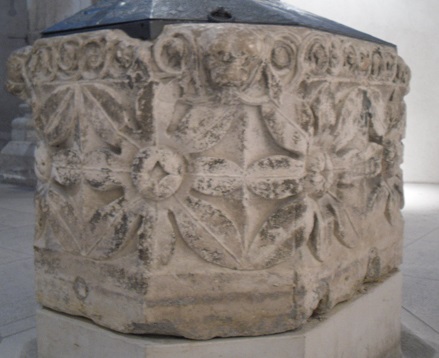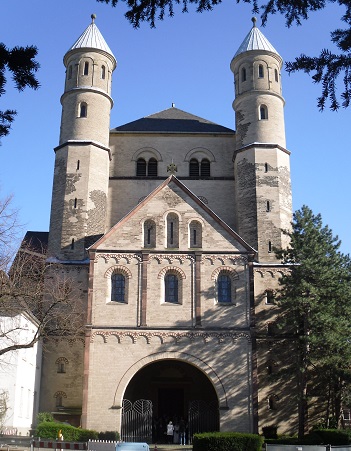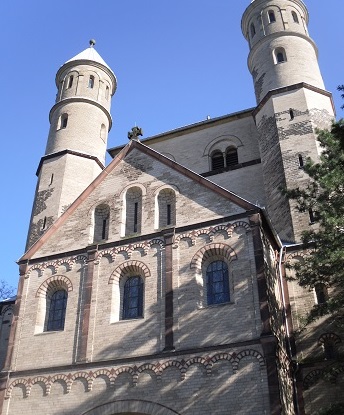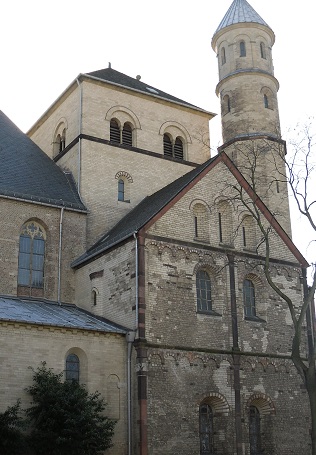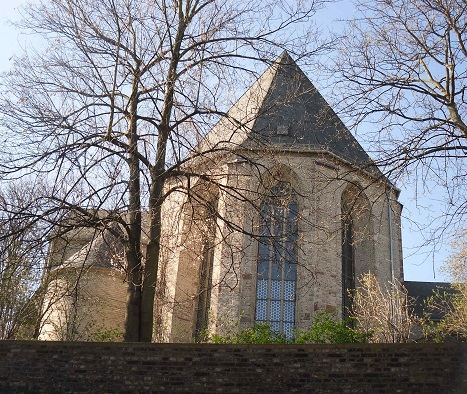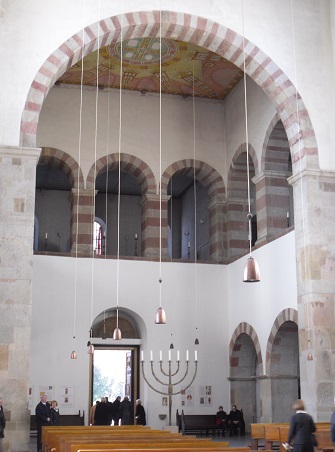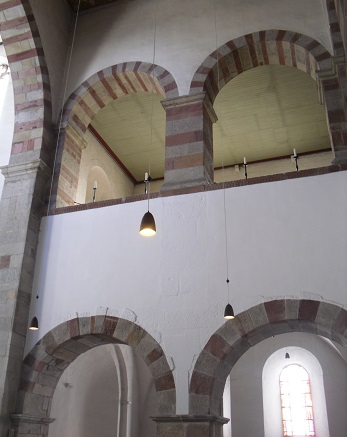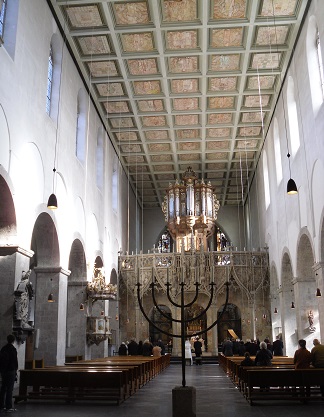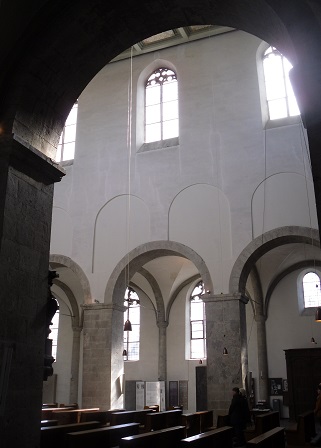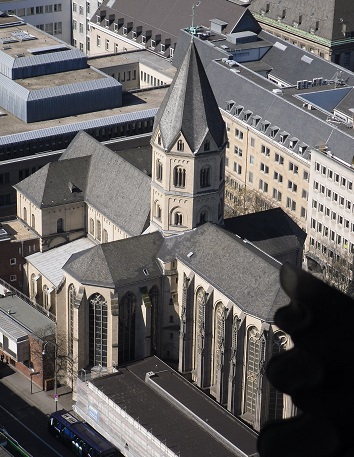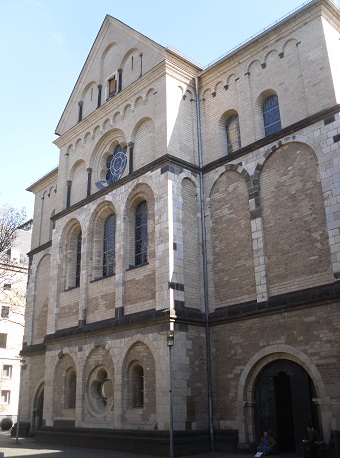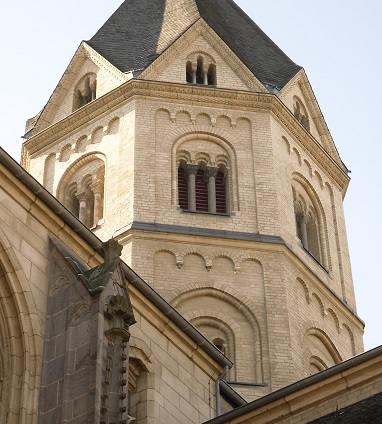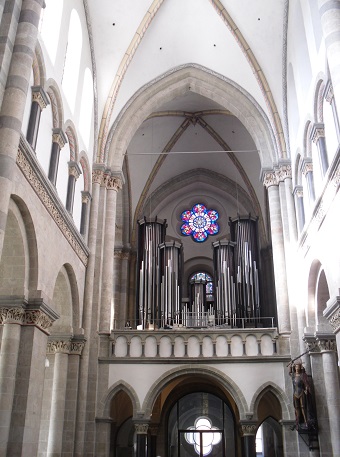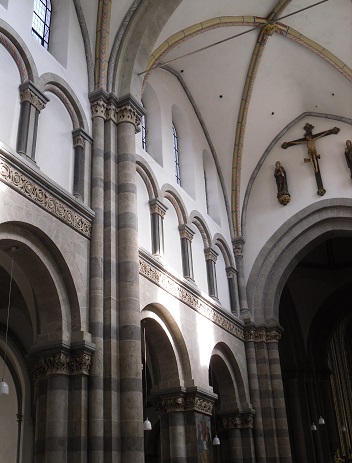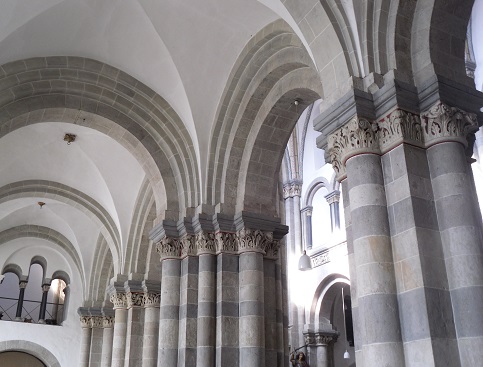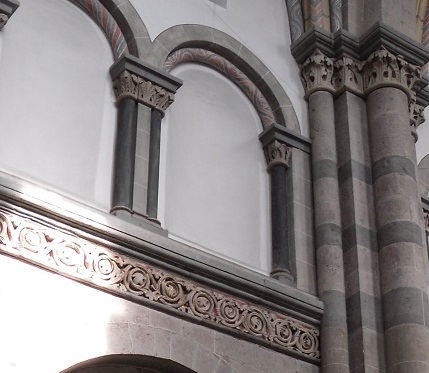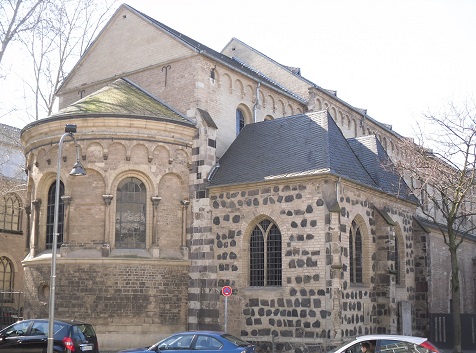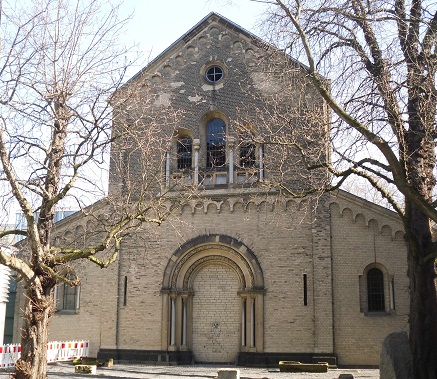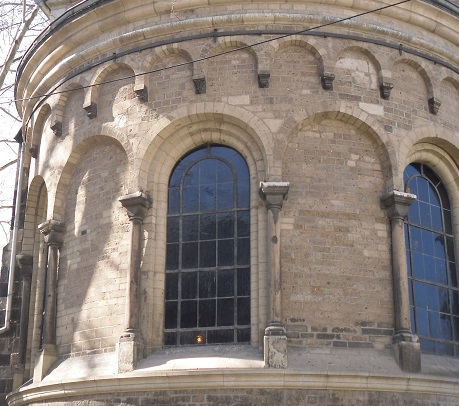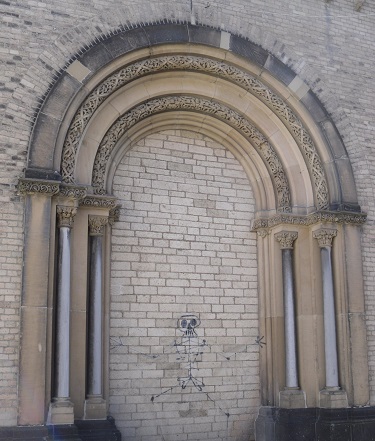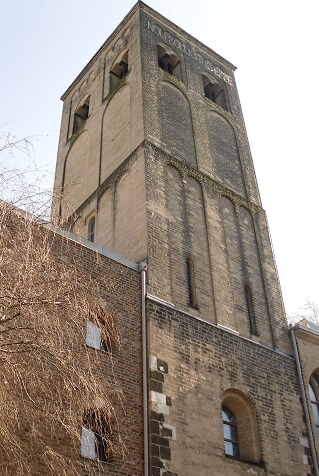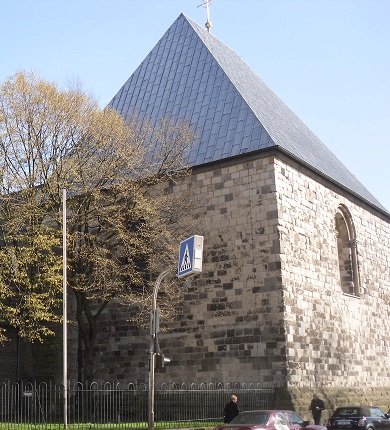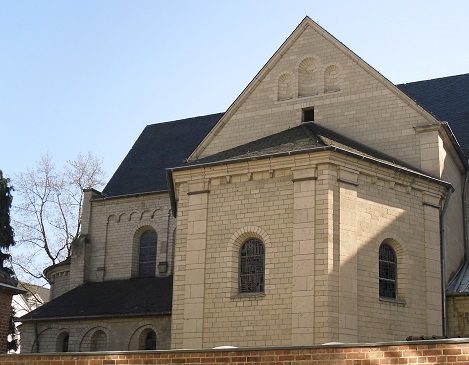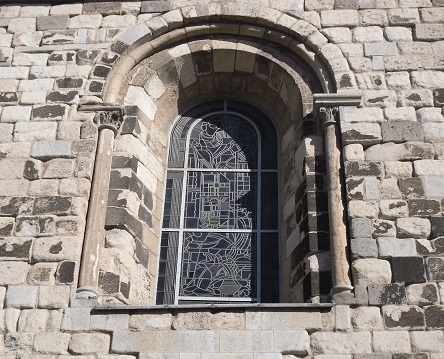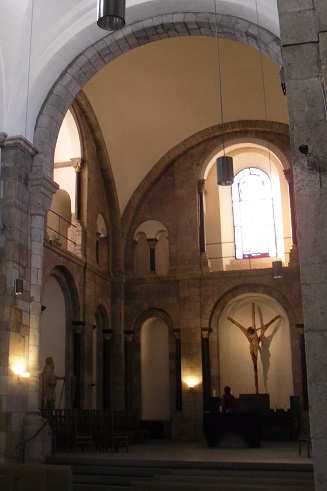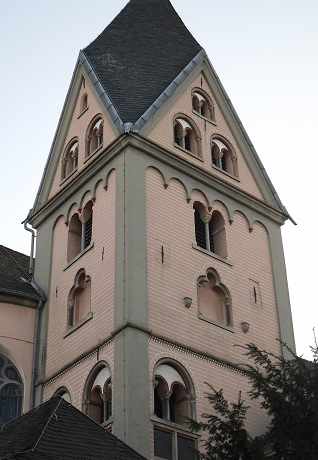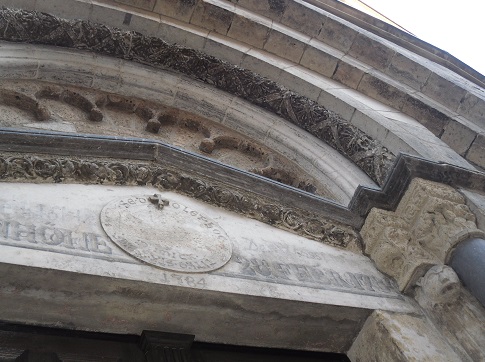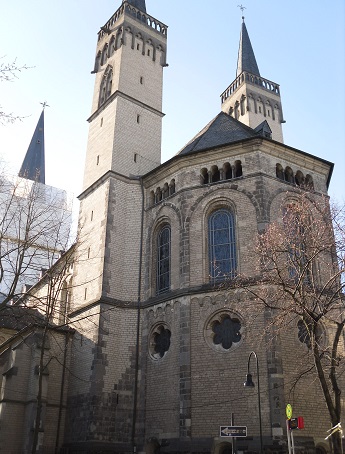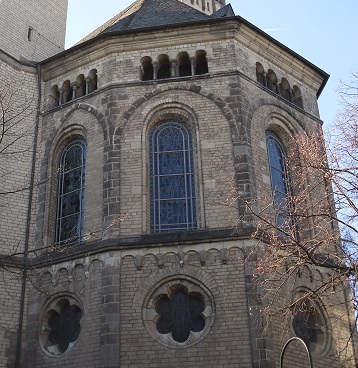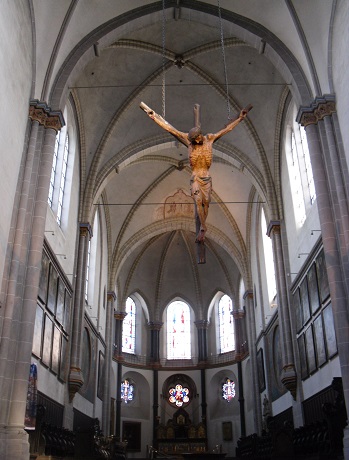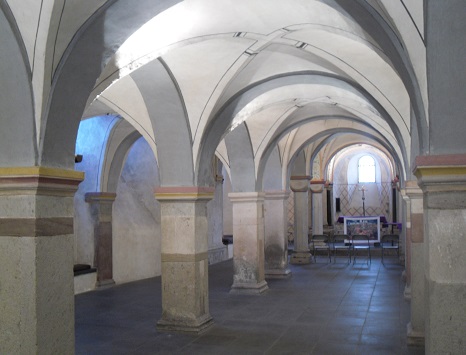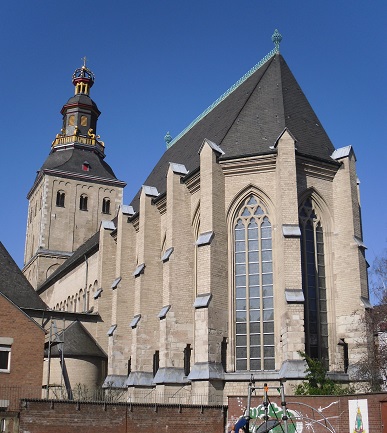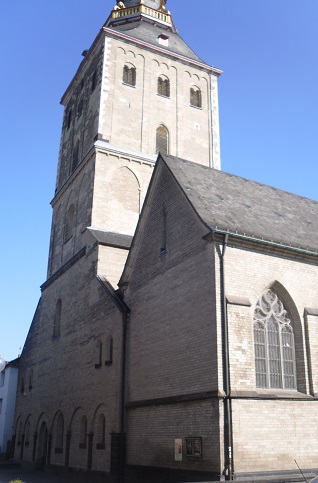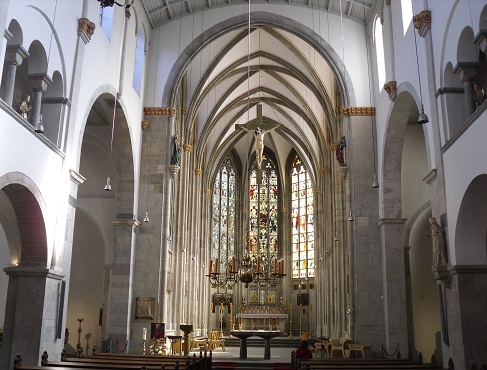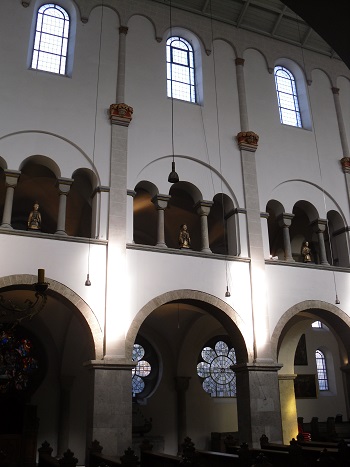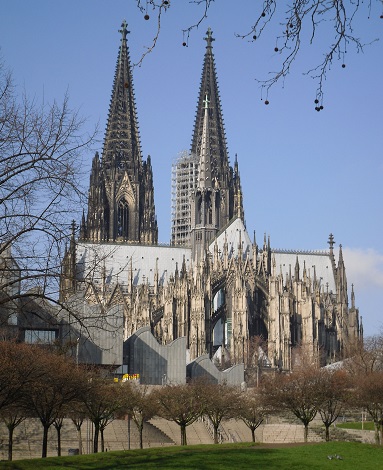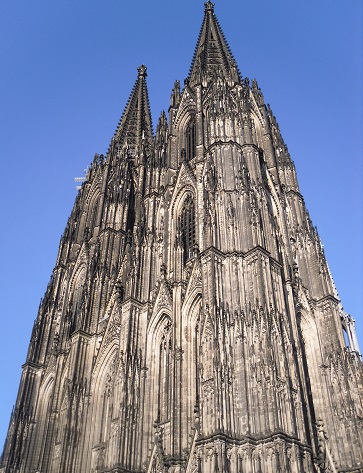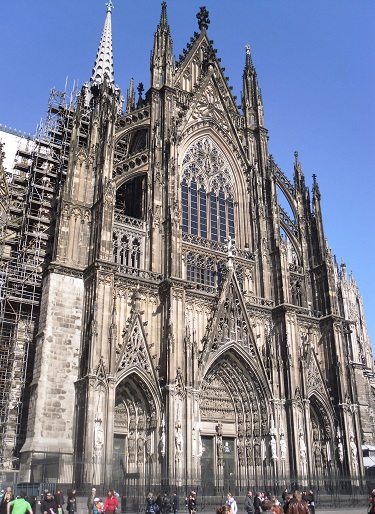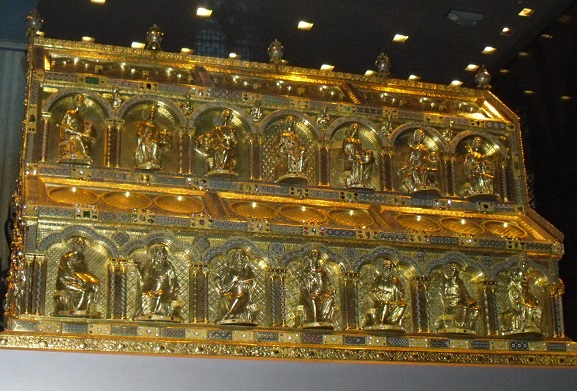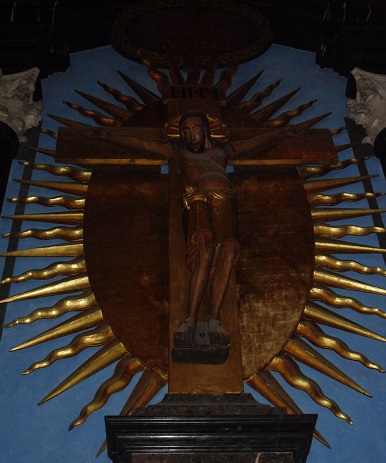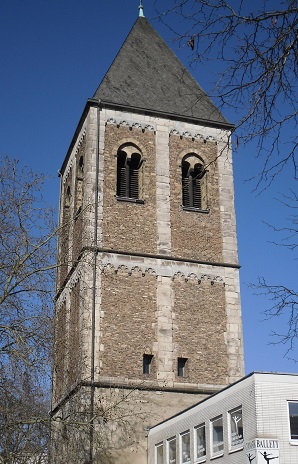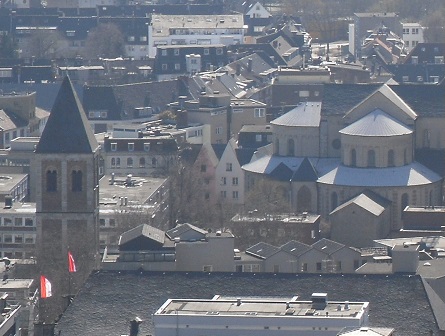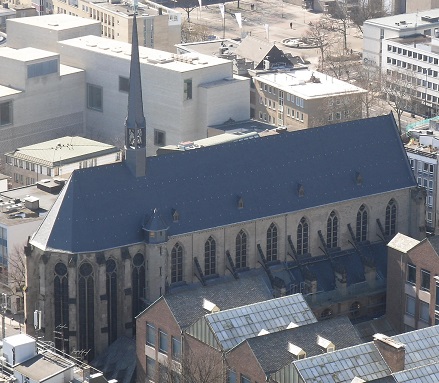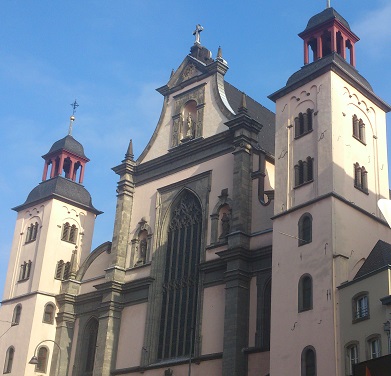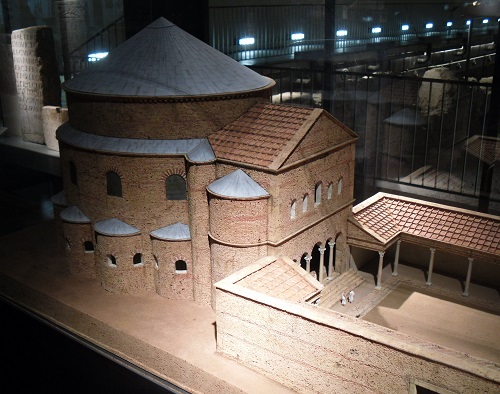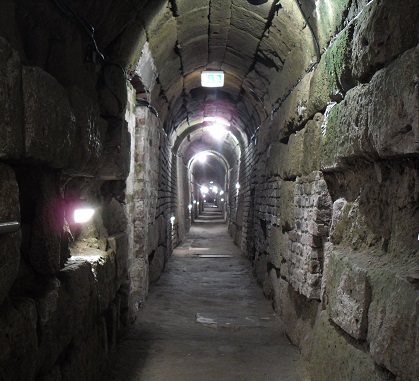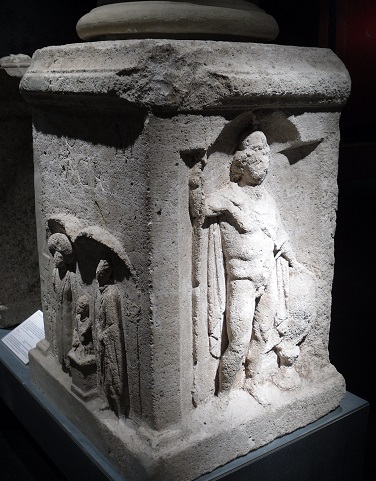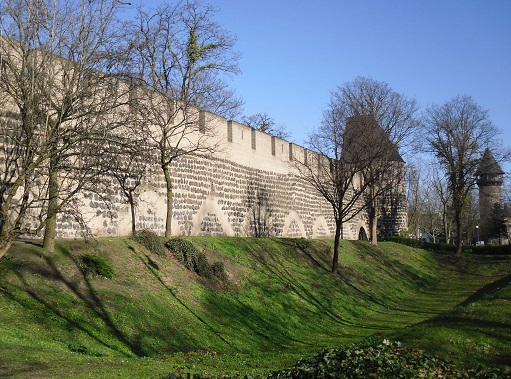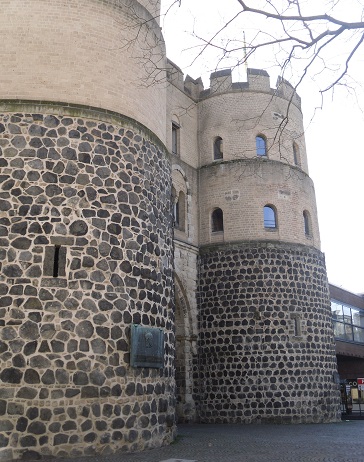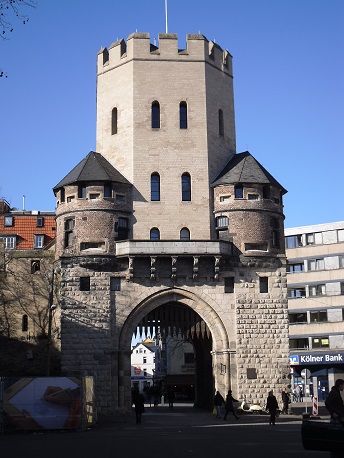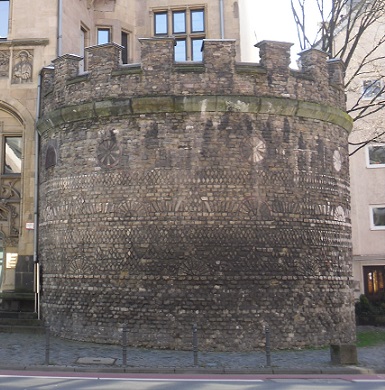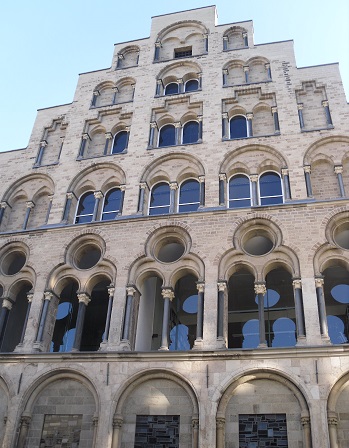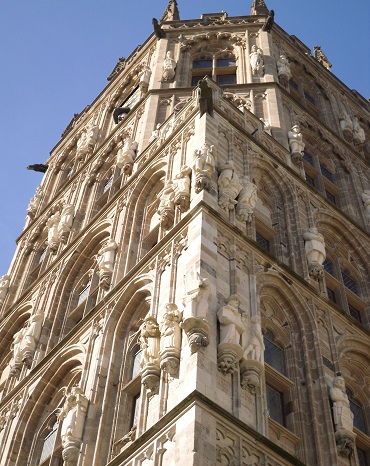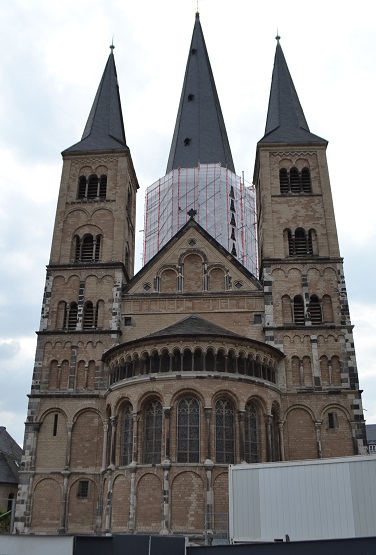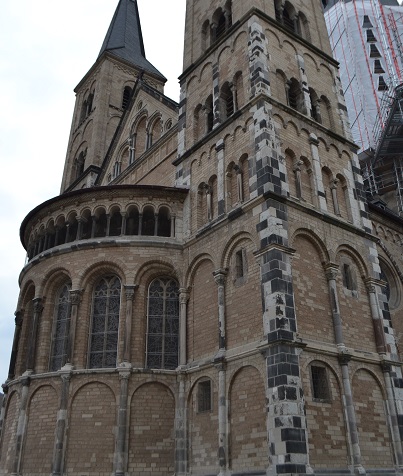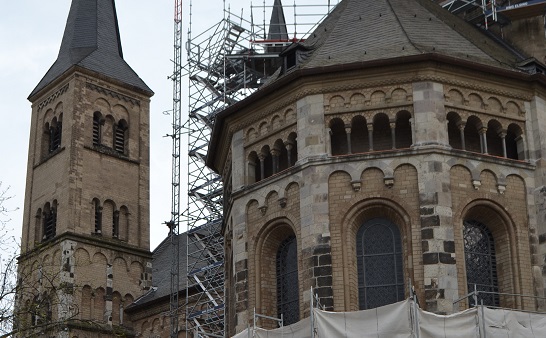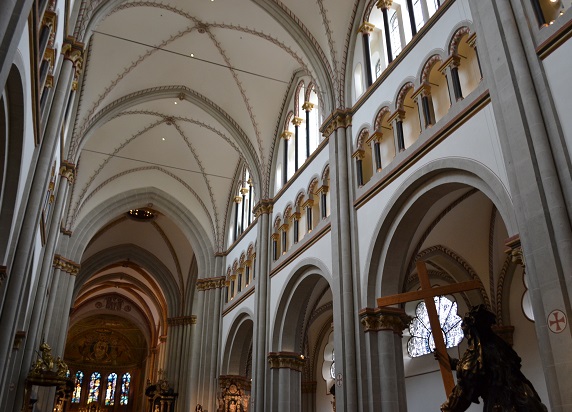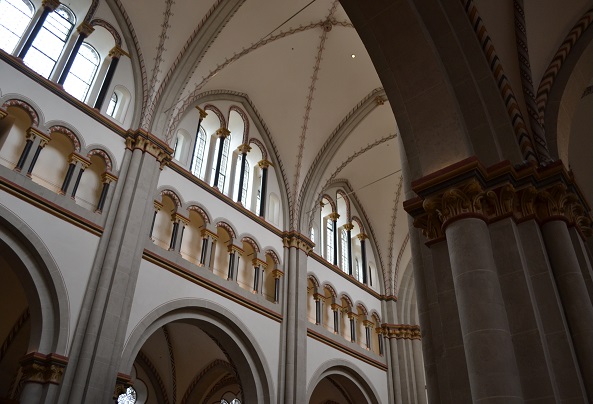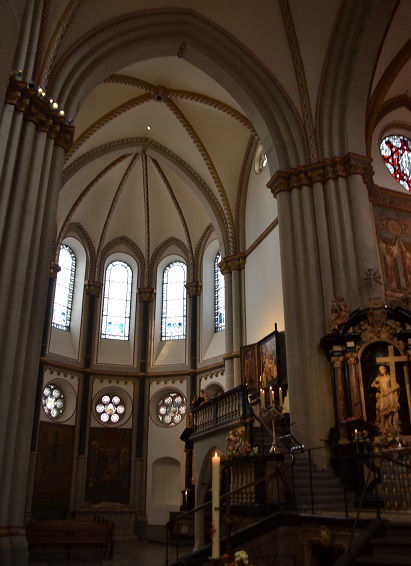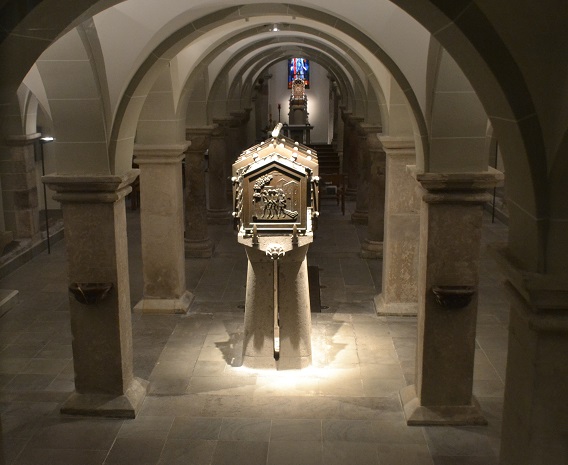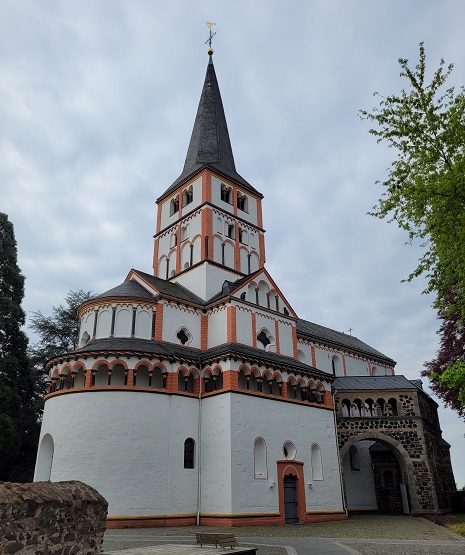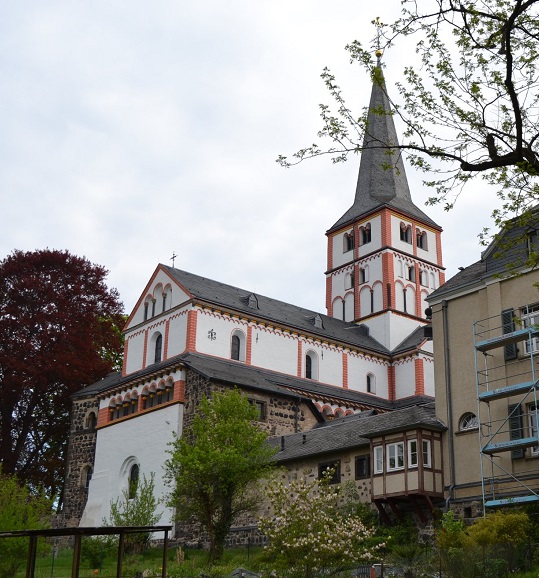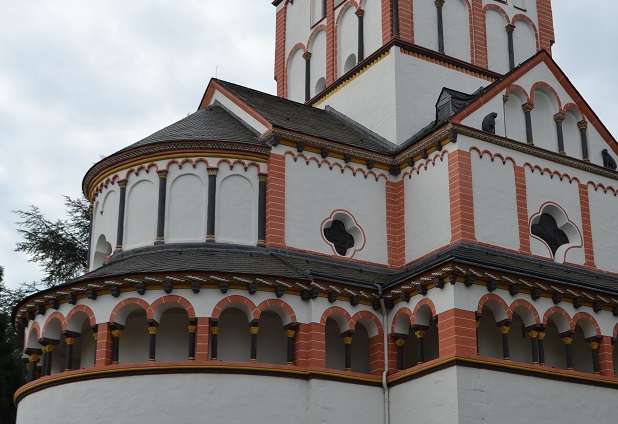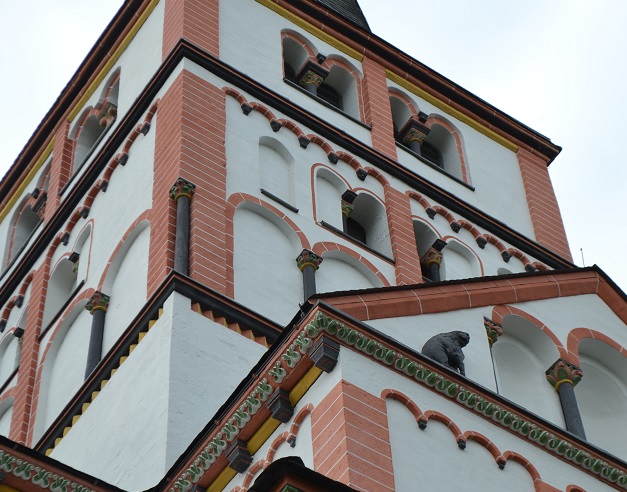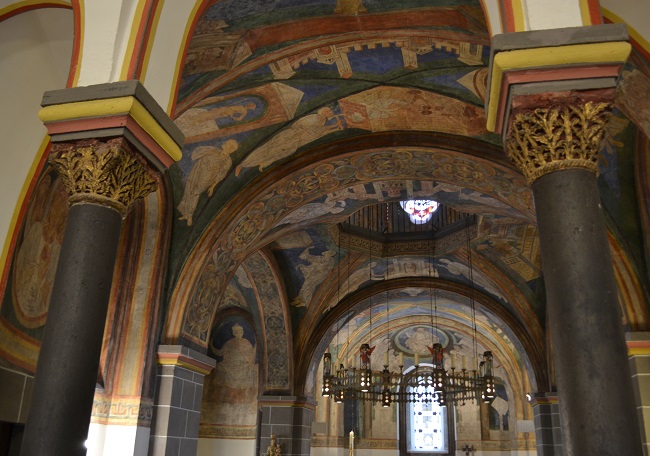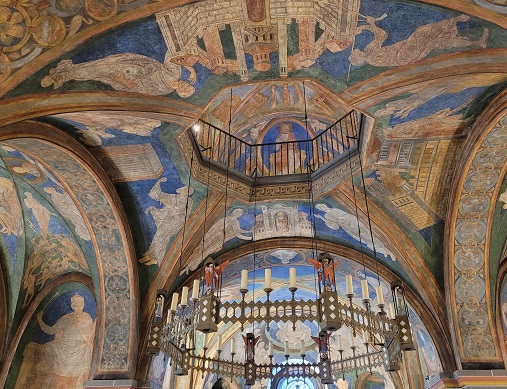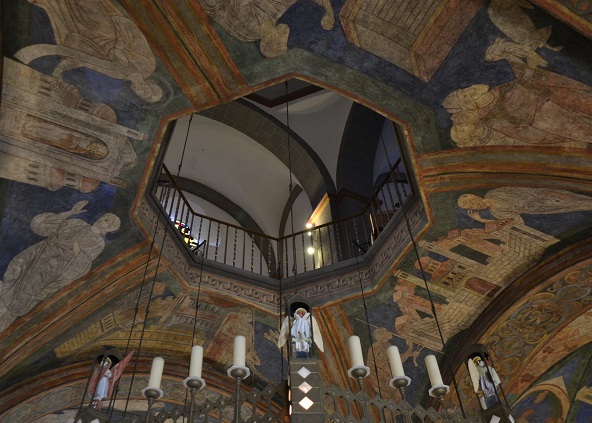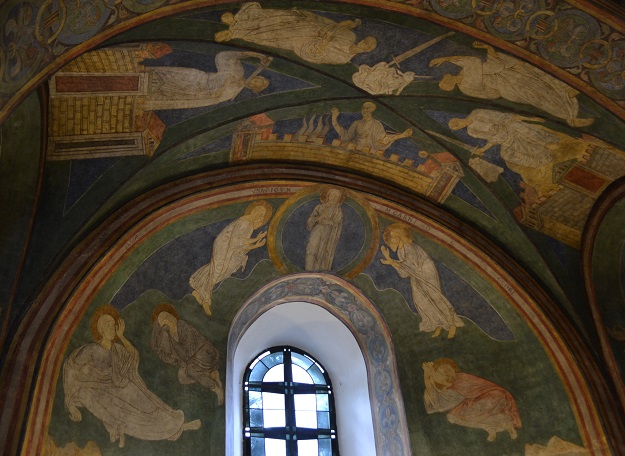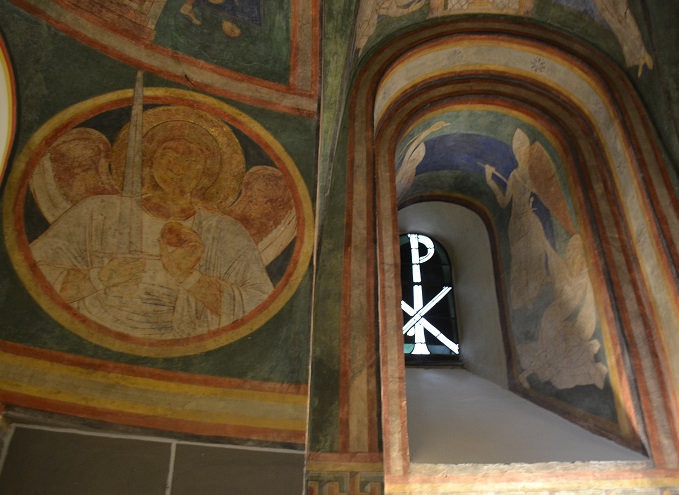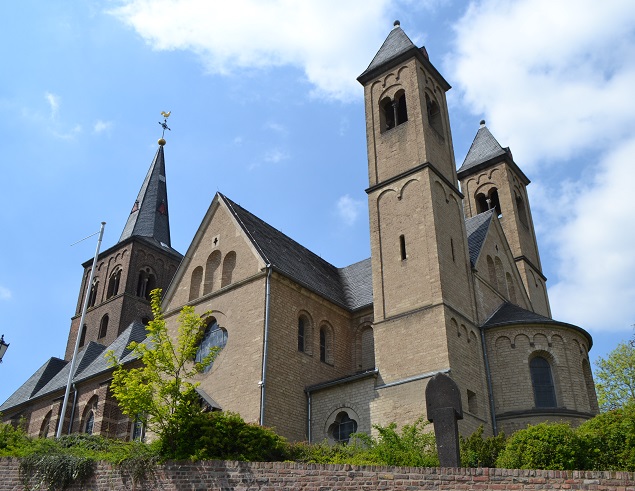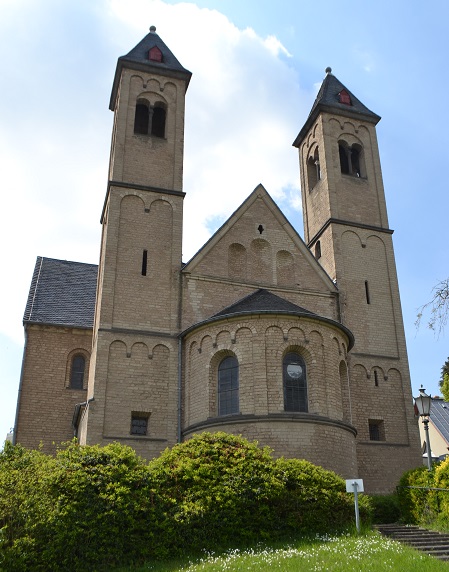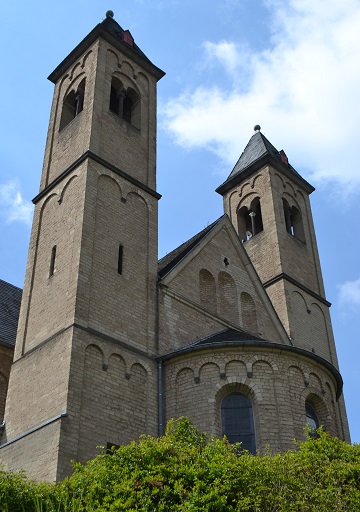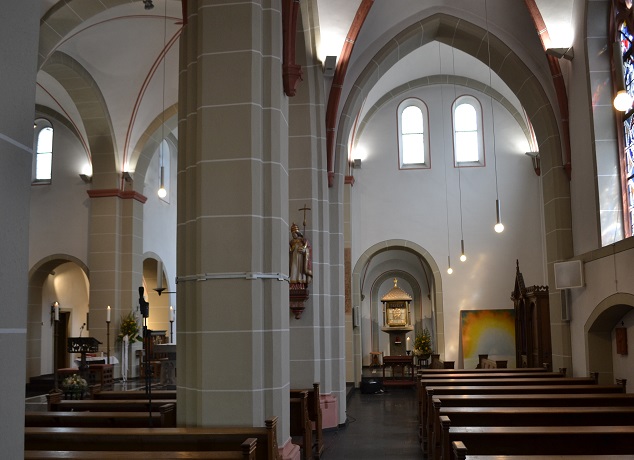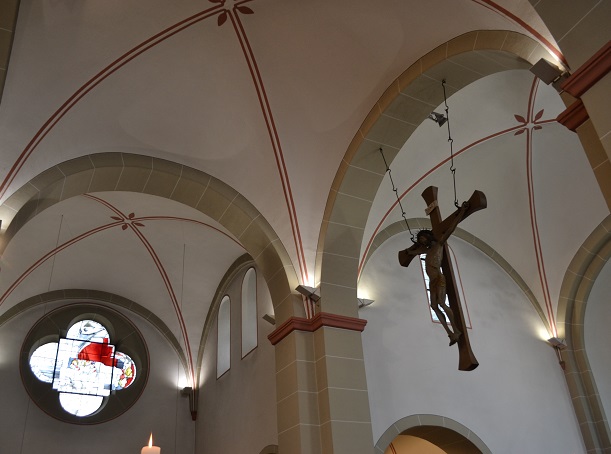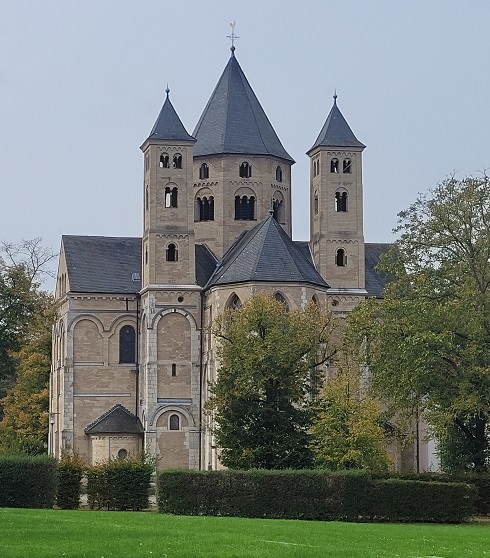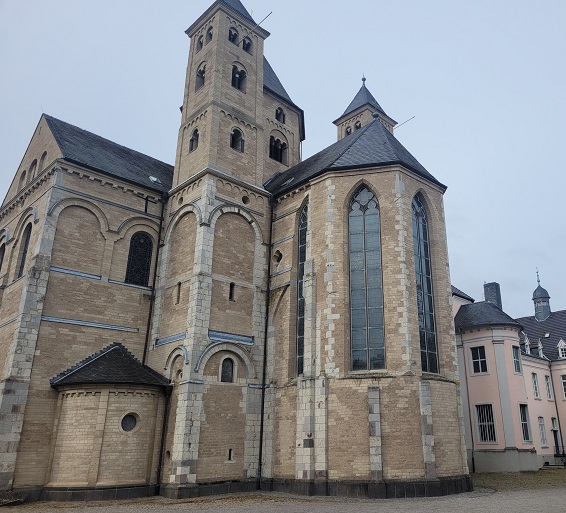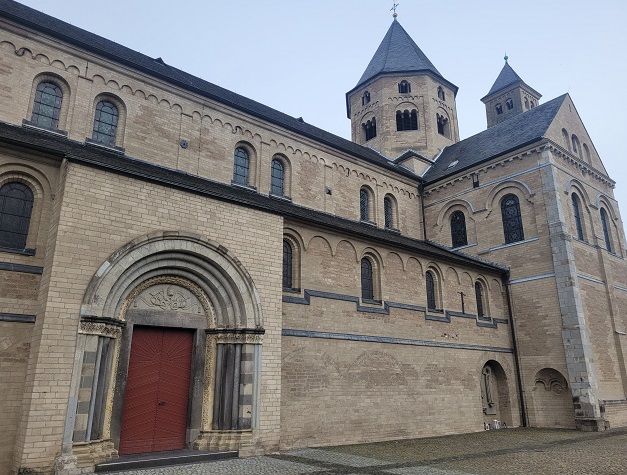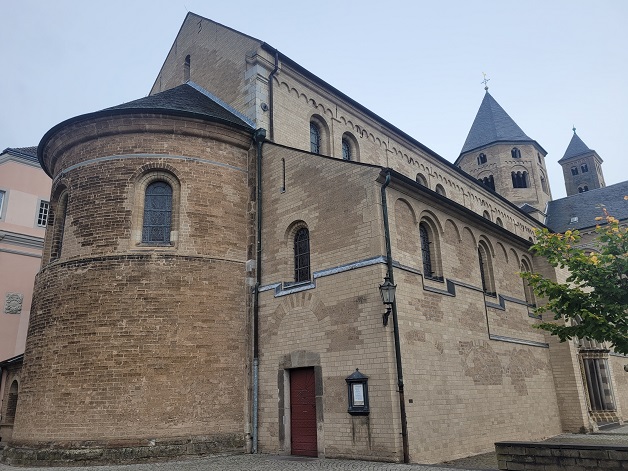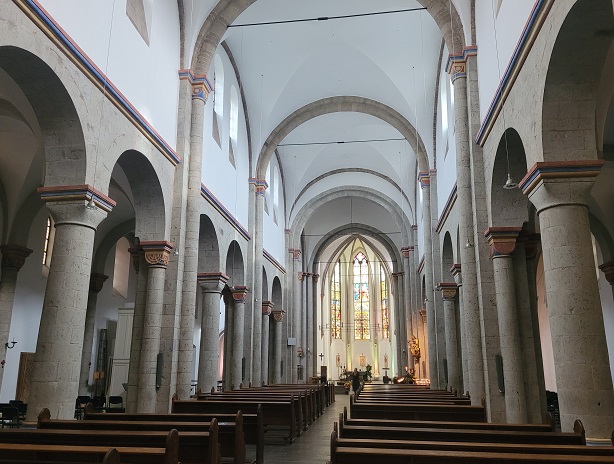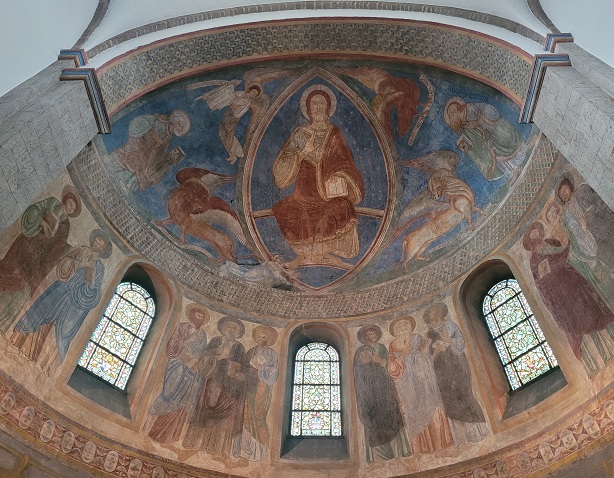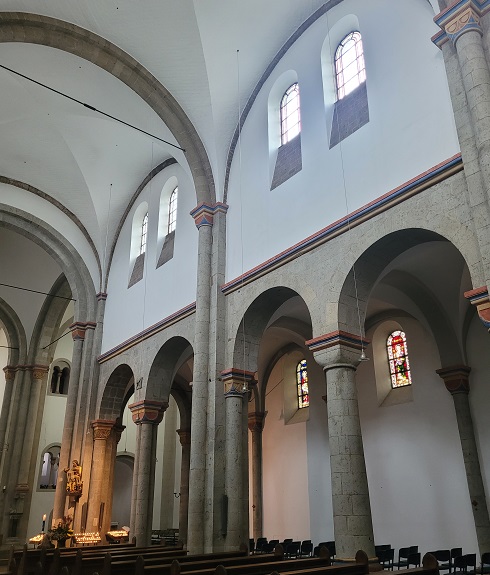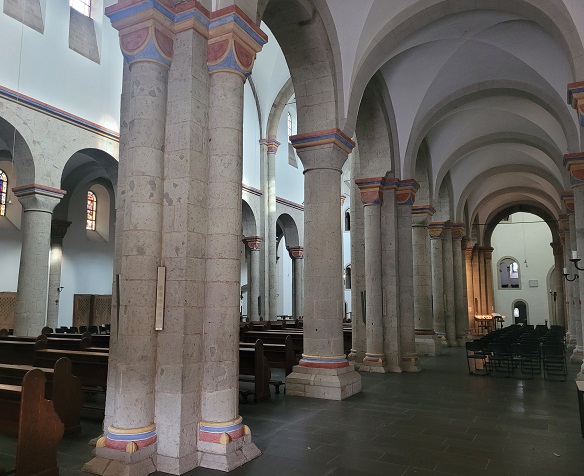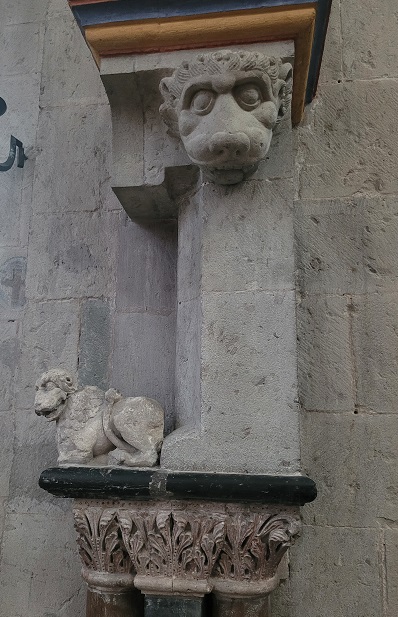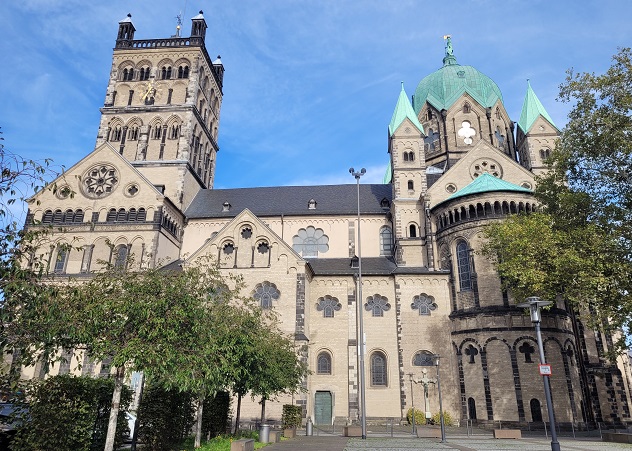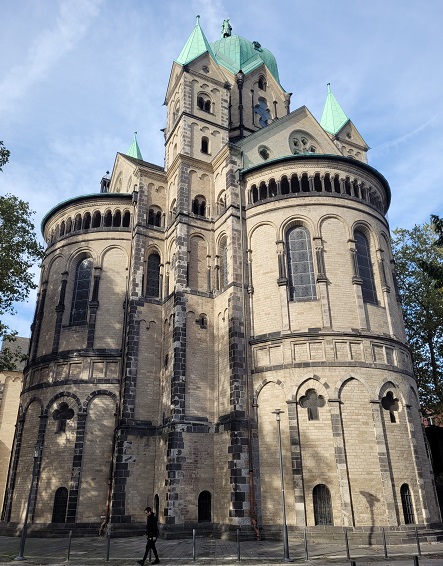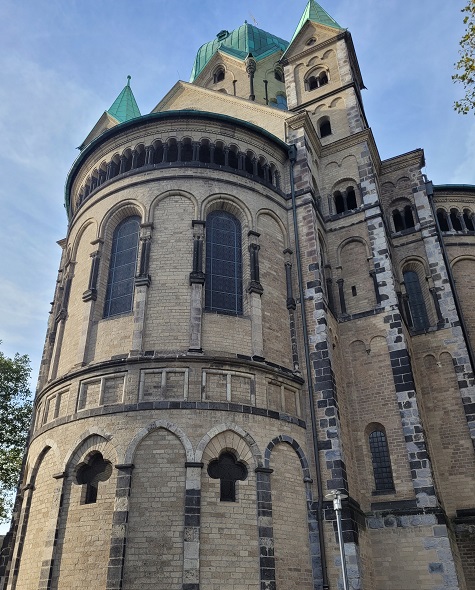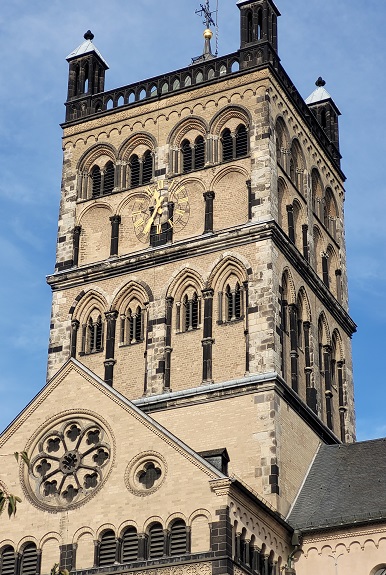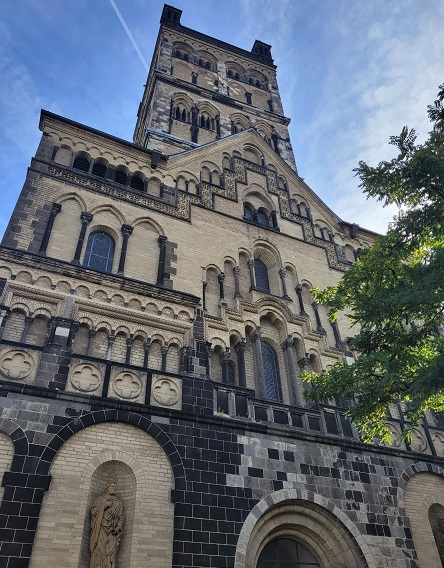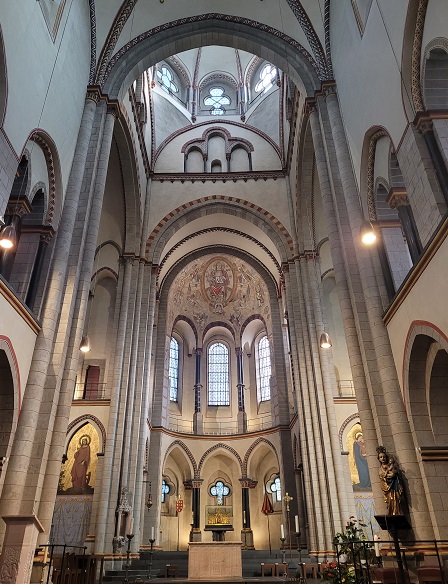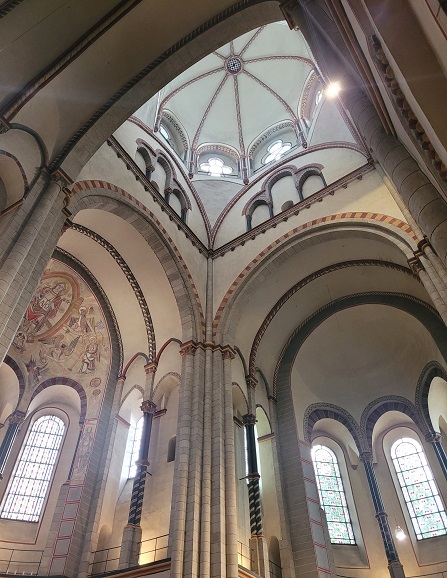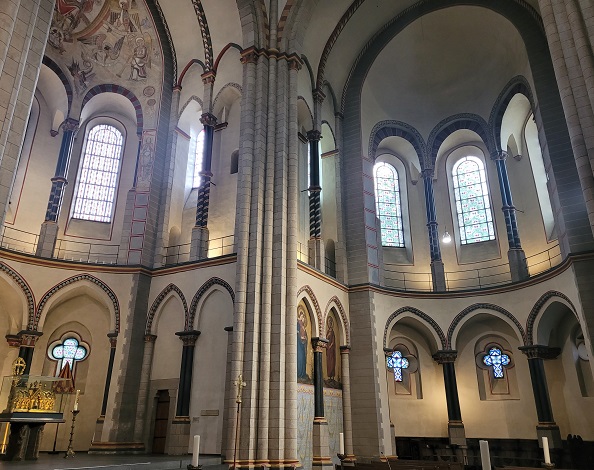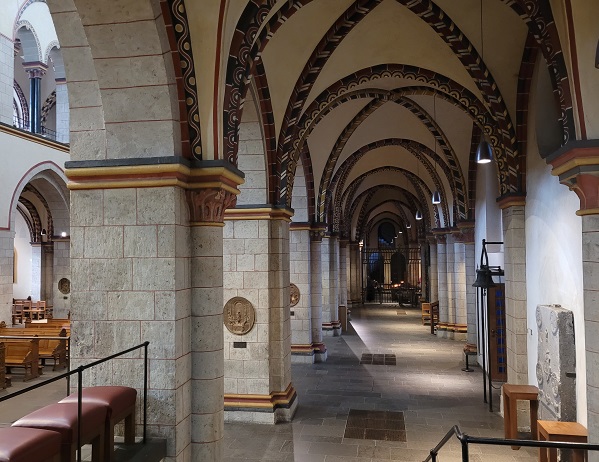|
|
Colonia
Romanica
Romanesque
churches in Köln (Cologne)
This page provides
an overview of the romanesque churches of the archbishopric city
of Cologne in western Germany. Despite heavy damage in the second
World War, the total of twelve main romanesque churches spread through
the city centre still represents a unique and impressive cultural
highlight. The original Rhenan romanesque style is characterized
by its western transepts, trefoil choirs in clover-leaf shape and
high ranking twin towers dominating the Rhine panorama. The style
originates in the 10th century from Ottonan influences and culminates
in the 12th century with richly decorated new constructions. Another
revival takes place in the first half of the 13th century, just
before the Cathedral would be rebuilt in gothic style. The page
is completed by some of the main romanesque churches in the surroundings
of Cologne, where monasteries and smaller towns provide more highlights
of the Rhenan style influenced by the regional capital.
Introduction
Main churches
More churches
Other
monuments
Surroundings
 Introduction
Introduction
Cologne was a major religious centre for centuries
and the biggest medieval town north of the Alps. The town developed
on the site of the roman Colonia Claudia Ara Agrippinensium.
In the 4th century, a first cathedral was built
near the city walls and a bishopric was established that turned
into on of the most important ones around. The 4th century witnessed
the construction of some more churches, such as the remarkable circular
building of S. Gereon outside the city walls and S. Severin which
was established in a roman graveyard on the south side of town.
S. Gereon became the sepulchral church of the Frankish kings. The
cathedral was rebuilt in carolingian style around 800 with a double
transept and double choir, which existed until it burnt down in
1248 and the gothic reconstruction started. Cologne kept on gaining
importance and it's defence walls extended outwards several times
(1106, 1180).
Construction of the romanesque churches of the
city covers the period from 950 to 1250. Most churches are imperial
or monastic foundations, only S. Maria Lyskirchen was originally
a parish church. The 10th century S. Pantaleon
is the oldest of the churches in town, originally part of a benedictine
abbey founded in 957 by Archbishop Bruno, the youn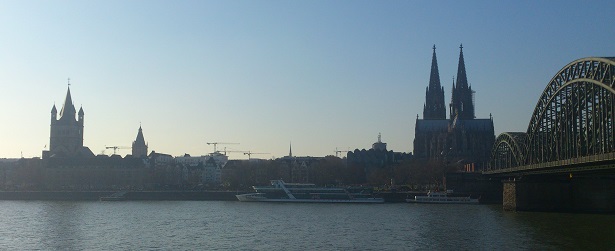 ger
brother of Emperor Otto the Great. The western transept with central
square tower from around 980 is a clear example of an ottonan style
westbau from the imperial tradition. The Gero crucifix in the cathedral
is also from the 10th century and the oldest one in town. The 11th
century was the period when the largest of the romanesque
churches was built : S. Maria im Kapitol. This long church with
it's flat ceilings and huge trefoil choir, the first one in Cologne
and the only one with ambulatories, was completed by 1065 and received
magnificently decorated doors. The basilical church of S. Georg,
with the only columned nave in town, was built in the same period.
In middle of the 11th century the Munster in Bonn is built, with
the choir and crypt remaining from this period. The churches of
S. Caecilien and S. Ursula with it's three-storied nave are from
the second quarter of the 12th century. Around
1150, the romanesque art or Cologne reached a culminating point,
greatly influencing architecture in the Rhineland. The westbau of
S. Aposteln, the trefoil choir of Gross S. Martin and the east choir
of the Bonn Munster date from this period and show a smart decoration
with arcading, dwarf galleries and flanking towers at the apses.
Other churches, such as S. Maria im Kapitol, received vaults replacing
the original ceilings. Outside the city, the opposing apses of the
Knechtsteden monastery church and the elegant two-storey double
church at Schwarzrheindorf mark other highly original constructions
from this period. In 1164, the cathedral acquired the relics of
the Three Magi, taken from Milan by Holy Roman Emperor Fredrick
Barbarossa. The relics attracted pilgrims from all over Christianity
and the famous relics shrine, an impressive work of medieval gold
craftsmanship started in 1190, can still be visited in the cathedral.
The large westbau of S. Georg and the transept of the Bonn Munster
are from the end of the 12th century and the trefoil choir of S.
Aposteln, the third one in town, is another masterpiece erected
around 1200. The first half of the 13th century
delivered the last group of romanesque churches in Cologne, where
rib vaults and pointed arches show the first early gothic elements.
In this group we can place S. Andreas, S. Maria Lyskirchen, S. Severin
and S. Kunibert. The latter was completed in 1247, a year before
the foundation stone was laid for the new cathedral and the gothic
style emerged definitely. Most of these churches have impressive
twin towers flanking the eastern apse. The nave of Gross S. Martin
belongs to the same period and the majestic decagon of S. Gereon,
erected in early gothic style on top of foundations from late antiquity,
is a masterpiece from about 1220. From this period we can also mention
the nave of the Bonn Munster and the Quirinus Munster at Neuss with
its impressive westbau and opposing trefoil choir. ger
brother of Emperor Otto the Great. The western transept with central
square tower from around 980 is a clear example of an ottonan style
westbau from the imperial tradition. The Gero crucifix in the cathedral
is also from the 10th century and the oldest one in town. The 11th
century was the period when the largest of the romanesque
churches was built : S. Maria im Kapitol. This long church with
it's flat ceilings and huge trefoil choir, the first one in Cologne
and the only one with ambulatories, was completed by 1065 and received
magnificently decorated doors. The basilical church of S. Georg,
with the only columned nave in town, was built in the same period.
In middle of the 11th century the Munster in Bonn is built, with
the choir and crypt remaining from this period. The churches of
S. Caecilien and S. Ursula with it's three-storied nave are from
the second quarter of the 12th century. Around
1150, the romanesque art or Cologne reached a culminating point,
greatly influencing architecture in the Rhineland. The westbau of
S. Aposteln, the trefoil choir of Gross S. Martin and the east choir
of the Bonn Munster date from this period and show a smart decoration
with arcading, dwarf galleries and flanking towers at the apses.
Other churches, such as S. Maria im Kapitol, received vaults replacing
the original ceilings. Outside the city, the opposing apses of the
Knechtsteden monastery church and the elegant two-storey double
church at Schwarzrheindorf mark other highly original constructions
from this period. In 1164, the cathedral acquired the relics of
the Three Magi, taken from Milan by Holy Roman Emperor Fredrick
Barbarossa. The relics attracted pilgrims from all over Christianity
and the famous relics shrine, an impressive work of medieval gold
craftsmanship started in 1190, can still be visited in the cathedral.
The large westbau of S. Georg and the transept of the Bonn Munster
are from the end of the 12th century and the trefoil choir of S.
Aposteln, the third one in town, is another masterpiece erected
around 1200. The first half of the 13th century
delivered the last group of romanesque churches in Cologne, where
rib vaults and pointed arches show the first early gothic elements.
In this group we can place S. Andreas, S. Maria Lyskirchen, S. Severin
and S. Kunibert. The latter was completed in 1247, a year before
the foundation stone was laid for the new cathedral and the gothic
style emerged definitely. Most of these churches have impressive
twin towers flanking the eastern apse. The nave of Gross S. Martin
belongs to the same period and the majestic decagon of S. Gereon,
erected in early gothic style on top of foundations from late antiquity,
is a masterpiece from about 1220. From this period we can also mention
the nave of the Bonn Munster and the Quirinus Munster at Neuss with
its impressive westbau and opposing trefoil choir.
The churches of Cologne also received important decorations
in the 12th and early 13th centuries, such as mosaics (S. Gereon),
murals (S. Maria Lyskirchen), tombstones (S. Maria im Kapitol),
crucifixes (S. Georg) and stained-glass (S. Kunibert). Still the
monumental sculpture of Cologne can be considered modest for the
romanesque period. The most important romanesque mural
paintings can be found outside the city, in the
apse of the Knechtsteden monastery and the vaults of Schwarzrheindorf,
both dating from just after 1150.
The churches of Cologne were repeatedly altered through later centuries.
The choirs of S.Andreas, S. Pantaleon, S.Ursula were rebuilt in
gothic style, while S. Severin was largely reconstructed in the
15th century with exception of the choir. Some other romanesque
churches completely disappeared such as S. Kolumba close to the
cathedral and S. Heribert on the eastbank of the Rhine. World
War II devastated the city centre of Cologne and caused
great damages to the romanesque churches. S. Aposteln, S. Maria
im Kapitol, Gross S. Martin and S. Georg had to be reconstructed
to a large extent in order to retrieve their original shapes. The
restoration of the churches was boosted in the 1970s. The Förderverein
Romanische Kirchen Köln was fouded in 1981 and Cologne
celebrated the Year of Romanesque Churches in 1985 when the churches
were reopened to the public. The churches were nominated on the
UNESCO world heritage list in 2013. Most of the churches can be
visited free of charge during regular hours throughout the week.
| |
Map of romanesque
churches in Cologne |
 Main romanesque churches
Main romanesque churches
S. APOSTELN
Nave (ca 1030); westbau, tower (ca 1150); trefoil choir, crypt (ca
1200); dome, vaults (early-13th).
S. GEREON
Choir, crypt (ca 1060-1070 and 12th); towers (12th); decagon (1219-1227;
base ca 380); mosaics (12th); murals; sarcophagus.
S. KUNIBERT
Westbau, nave, transept, towers, choir (1215-1247); stained-glass
windows (ca 1230).
S. MARIA IM KAPITOL
Nave, transept, trefoil choir, crypt (1040-1065); transept vaults
(ca 1150); doors (ca 1060-1065); Plektrudis tombstone (ca 1160-1170);
cloisters.
GROSS S. MARTIN
Trefoil choir, tower (ca 1150-1172); nave (ca 1230); baptismal font
(13th).
S. PANTALEON
Westbau, tower, nave, transept (966-980); side-aisles (ca 1150-1160);
crypt; relic shrines (late-12th); sculptures; cloisters.
 More romanesque churches
More romanesque churches
S. ANDREAS
Westbau, nave, crossing, tower (ca 1200-1220); crypt (11th).
S. CAECILIEN (& S. PETER)
Nave, choir, portal (ca 1130-1160); crypt (10th); Schnütgen
Museum for Medieval Art; tympanum relief (ca 1160); Tower of St.
Peter (ca 1170).
S. GEORG
Nave columns, transept, choir (1056-1067); vaults, pillars (mid-12th);
westbau (ca 1180-1188); crucifix (ca 1070, replica).
S. MARIA LYSKIRCHEN
Nave, choir, tower, portal (ca 1210-1220); murals (mid-13th).
S. SEVERIN
Choir, towers (ca 1230) ; crypt (ca 1030-1040).
S. URSULA
Westbau, tower, nave and transept (ca 1135); sarcophagus (12th).
 Other monuments
Other monuments
DOM S. PETER & MARIA
Gothic cathedral (1248-1473); Magi relics shrine (ca 1190-1220);
Gero crucifix (ca 960); baptistery ruins (9th); Cathedral treasury;
Archbishopric Diocesan Museum.
KLEIN S. MARTIN
Tower (12th, rebuilt).
OTHER CHURCHES
Minoritenkirche S. Maria Empfangnis (14th), Antoniterkirche (14th;
baptismal font 12th), S. Maria Himmelfahrt (17th).
PRAETORIUM
Roman substructures (1st-4th).
CITY WALLS
Walls, Hahnentor, Eigelsteintor, Severinstor, Römerturm.
CIVIL MONUMENTS
Overstolzenhaus, Rathaus.
 Surroundings
Surroundings
BONN, S. CASSIUS
MUNSTER
Choir, crypt (ca 1050); apse, east towers (ca 1150): trefoil transept
and central tower (late-12th); nave (1220-1240); cloisters (12th).
SCHWARZRHEINDORF (BEUEL), S.CLEMENS
Double church (after 1150): nave, tower, apse; murals.
BERGHEIM, S. REMIGIUS
Transept, towers, choir (ca 1175).
KNECHTSTEDEN (DORMAGEN), S. ANDREAS KLOSTER
Nave, transept, towers, opposing apses (1138-1181); capitals; murals
(1164).
NEUSS, S. QUIRINUS MUNSTER
Westbau, nave, transept, towers, trefoil choir (1209-1230); inscription.
Web links
Official sites
http://www.romanische-kirchen.de/
http://www.koelner-dom.de/
http://www.st-aposteln.de/
http://www.st-kunibert-koeln.de/
http://www.maria-im-kapitol.de/
http://www.lyskirchen.com/
http://www.sankt-pantaleon.de/
http://www.cologne.de/what-to-do/sightseeing/romanic-churches.html
http://www.koeln.de/tourismus/sehenswertes/kirchen
http://www.cologne-tourism.com/attractions-culture/romanesque-churches.html
http://www.willkommeninkoeln.de/01city/city06-3d.htm
Pages about the churches
of Cologne
http://www.sacred-destinations.com/germany/cologne
http://kulturreise-ideen.de/architektur/romanik/Tour-romanische-kirchen-in-koeln.html
http://www.koeln-altstadt.de/kultur/romanischekirchen/
http://www.podtours.co.uk/Romanesque-churches-cologne.html
http://www.gpsmycity.com/tours/the-churches-of-cologne-1346.html
http://www.koelnerfoto.de/Seitenauto/KOELN/KIRCHEN_FRIEDHOF/K_ROMANIK1/
https://en.wikipedia.org/wiki/Twelve_Romanesque_churches_of_Cologne
https://de.wikipedia.org/wiki/F%C3%B6rderverein_Romanische_Kirchen_K%C3%B6ln
Pictures: Eduard, 2011. For any comments or
additions feel free to contact me.
[top]
[homepage] [contact] |
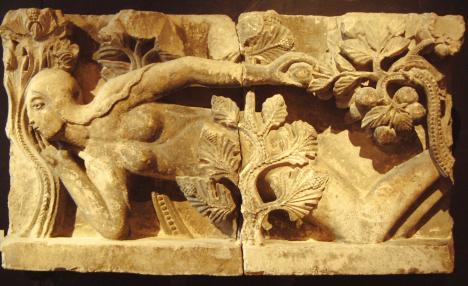
 ger
brother of Emperor Otto the Great. The western transept with central
square tower from around 980 is a clear example of an ottonan style
westbau from the imperial tradition. The Gero crucifix in the cathedral
is also from the 10th century and the oldest one in town. The 11th
century was the period when the largest of the romanesque
churches was built : S. Maria im Kapitol. This long church with
it's flat ceilings and huge trefoil choir, the first one in Cologne
and the only one with ambulatories, was completed by 1065 and received
magnificently decorated doors. The basilical church of S. Georg,
with the only columned nave in town, was built in the same period.
In middle of the 11th century the Munster in Bonn is built, with
the choir and crypt remaining from this period. The churches of
S. Caecilien and S. Ursula with it's three-storied nave are from
the second quarter of the 12th century. Around
1150, the romanesque art or Cologne reached a culminating point,
greatly influencing architecture in the Rhineland. The westbau of
S. Aposteln, the trefoil choir of Gross S. Martin and the east choir
of the Bonn Munster date from this period and show a smart decoration
with arcading, dwarf galleries and flanking towers at the apses.
Other churches, such as S. Maria im Kapitol, received vaults replacing
the original ceilings. Outside the city, the opposing apses of the
Knechtsteden monastery church and the elegant two-storey double
church at Schwarzrheindorf mark other highly original constructions
from this period. In 1164, the cathedral acquired the relics of
the Three Magi, taken from Milan by Holy Roman Emperor Fredrick
Barbarossa. The relics attracted pilgrims from all over Christianity
and the famous relics shrine, an impressive work of medieval gold
craftsmanship started in 1190, can still be visited in the cathedral.
The large westbau of S. Georg and the transept of the Bonn Munster
are from the end of the 12th century and the trefoil choir of S.
Aposteln, the third one in town, is another masterpiece erected
around 1200. The first half of the 13th century
delivered the last group of romanesque churches in Cologne, where
rib vaults and pointed arches show the first early gothic elements.
In this group we can place S. Andreas, S. Maria Lyskirchen, S. Severin
and S. Kunibert. The latter was completed in 1247, a year before
the foundation stone was laid for the new cathedral and the gothic
style emerged definitely. Most of these churches have impressive
twin towers flanking the eastern apse. The nave of Gross S. Martin
belongs to the same period and the majestic decagon of S. Gereon,
erected in early gothic style on top of foundations from late antiquity,
is a masterpiece from about 1220. From this period we can also mention
the nave of the Bonn Munster and the Quirinus Munster at Neuss with
its impressive westbau and opposing trefoil choir.
ger
brother of Emperor Otto the Great. The western transept with central
square tower from around 980 is a clear example of an ottonan style
westbau from the imperial tradition. The Gero crucifix in the cathedral
is also from the 10th century and the oldest one in town. The 11th
century was the period when the largest of the romanesque
churches was built : S. Maria im Kapitol. This long church with
it's flat ceilings and huge trefoil choir, the first one in Cologne
and the only one with ambulatories, was completed by 1065 and received
magnificently decorated doors. The basilical church of S. Georg,
with the only columned nave in town, was built in the same period.
In middle of the 11th century the Munster in Bonn is built, with
the choir and crypt remaining from this period. The churches of
S. Caecilien and S. Ursula with it's three-storied nave are from
the second quarter of the 12th century. Around
1150, the romanesque art or Cologne reached a culminating point,
greatly influencing architecture in the Rhineland. The westbau of
S. Aposteln, the trefoil choir of Gross S. Martin and the east choir
of the Bonn Munster date from this period and show a smart decoration
with arcading, dwarf galleries and flanking towers at the apses.
Other churches, such as S. Maria im Kapitol, received vaults replacing
the original ceilings. Outside the city, the opposing apses of the
Knechtsteden monastery church and the elegant two-storey double
church at Schwarzrheindorf mark other highly original constructions
from this period. In 1164, the cathedral acquired the relics of
the Three Magi, taken from Milan by Holy Roman Emperor Fredrick
Barbarossa. The relics attracted pilgrims from all over Christianity
and the famous relics shrine, an impressive work of medieval gold
craftsmanship started in 1190, can still be visited in the cathedral.
The large westbau of S. Georg and the transept of the Bonn Munster
are from the end of the 12th century and the trefoil choir of S.
Aposteln, the third one in town, is another masterpiece erected
around 1200. The first half of the 13th century
delivered the last group of romanesque churches in Cologne, where
rib vaults and pointed arches show the first early gothic elements.
In this group we can place S. Andreas, S. Maria Lyskirchen, S. Severin
and S. Kunibert. The latter was completed in 1247, a year before
the foundation stone was laid for the new cathedral and the gothic
style emerged definitely. Most of these churches have impressive
twin towers flanking the eastern apse. The nave of Gross S. Martin
belongs to the same period and the majestic decagon of S. Gereon,
erected in early gothic style on top of foundations from late antiquity,
is a masterpiece from about 1220. From this period we can also mention
the nave of the Bonn Munster and the Quirinus Munster at Neuss with
its impressive westbau and opposing trefoil choir.